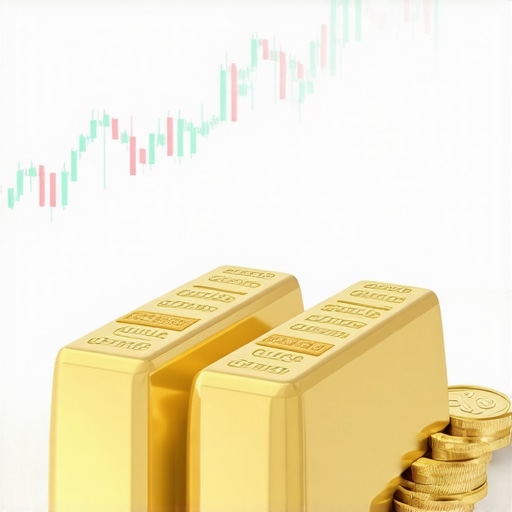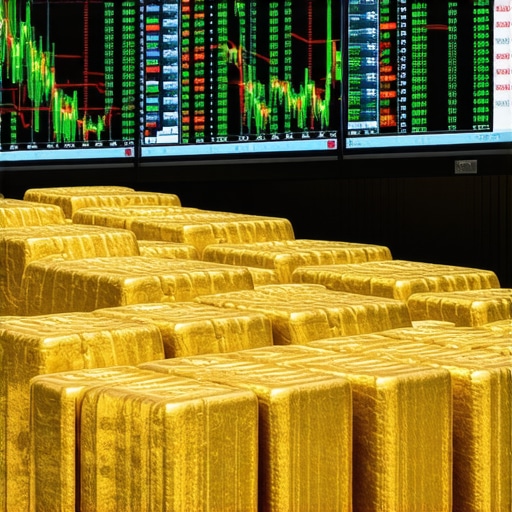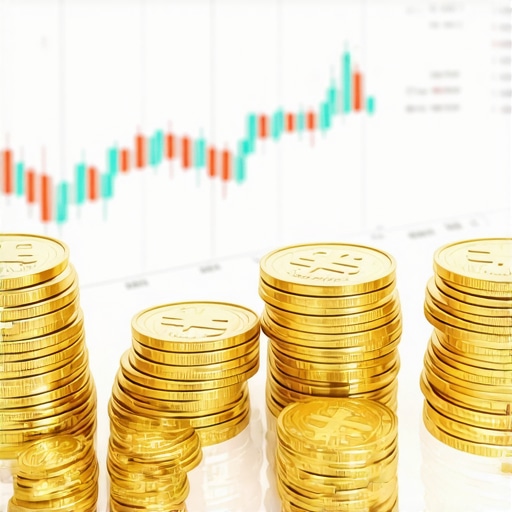Unveiling the Golden Equation: Supply Meets Demand in 2025
Gold’s allure as a timeless store of value hinges fundamentally on the delicate balance between its supply and demand. As we venture into 2025, understanding the nuances behind these forces is crucial for investors and enthusiasts alike. The global gold market is not just influenced by mining outputs but also by geopolitical tensions, central bank policies, and shifts in consumer behavior. These elements intertwine, crafting a complex tapestry that dictates price movements.
Mining Output vs. Recycling: The Twin Pillars of Gold Supply
On the supply side, gold production is constrained by geological and economic factors. The discovery of new deposits is rare, and mining costs continue to rise, making incremental increases in supply challenging. Meanwhile, gold recycling plays a pivotal role, contributing approximately one-third of total supply. In 2025, rising scrap gold flows—driven by higher prices—could offset stagnating mine production, creating dynamic supply scenarios that savvy investors must monitor closely.
Demand Drivers: Beyond Jewelry to Technology and Finance
The demand for gold extends beyond traditional jewelry markets. Central banks remain significant buyers, diversifying reserves amid economic uncertainty. Furthermore, the technology sector increasingly consumes gold for electronics and medical devices due to its excellent conductivity and biocompatibility. Investment demand, including ETFs, mutual funds, and physical bullion, also surges as investors seek safe havens. These multifaceted demand streams collectively pressure prices upward, especially when supply growth is limited.
How Do Shifts in Gold Demand Impact Price Volatility in 2025?
Demand fluctuations, particularly in investment and central bank buying, can cause pronounced price volatility. For instance, unexpected geopolitical events might trigger rapid shifts in investor sentiment, pushing demand for gold as a hedge. Additionally, policy changes in major economies affect currency valuations, indirectly influencing gold’s appeal. Thus, understanding these demand shifts equips investors to anticipate and navigate price swings more effectively.
Expert Insight: Navigating Gold Investment Amid Supply-Demand Complexities
Experienced investors recognize that gold’s price movements are rarely linear. Integrating supply constraints with demand trends reveals periods where prices may spike or stabilize. For example, limited mine output combined with robust central bank purchases can create upward pressure. Conversely, surges in gold recycling or reduced investment demand might temper price increases. This interplay is crucial for crafting nuanced investment strategies.
For those seeking to deepen their understanding, exploring understanding gold supply and demand for smart investing offers valuable perspectives.
Driving Your Strategy Forward: Engage and Share Your Thoughts
How do you anticipate gold’s supply-demand dynamics influencing your investment approach in 2025? Share your views and experiences in the comments below. Engaging with a community of informed investors can sharpen insights and reveal opportunities often overlooked.
For a comprehensive look at what investors need to know for the coming year, consider reading our detailed 2025 gold price forecast.
According to the World Gold Council, global gold demand is expected to remain robust through 2025, driven by investment and technology sectors, underscoring the metal’s enduring significance (World Gold Council Data).
Reflections on Gold’s Supply Constraints: A Personal Take
Having observed the gold market for several years now, I’ve come to appreciate how supply limitations are more than just numbers on a report—they represent real, tangible challenges. When I first started investing, I underestimated how geological scarcity and rising extraction costs could tighten supply. It wasn’t until I dug deeper into mining trends that I realized why new gold discoveries have become so rare and expensive. This scarcity, paired with the cyclical nature of recycling flows, means investors need to stay alert to subtle shifts. For example, when scrap gold surges during periods of high prices, it can temporarily relieve supply pressures. But relying on recycling alone isn’t a sustainable strategy for long-term growth.
Demand’s Many Faces: Beyond the Bling
One of the most eye-opening lessons for me has been recognizing the diverse demand drivers beyond just jewelry. Central banks’ strategic gold acquisitions have always intrigued me, especially as nations seek to diversify reserves amid global economic uncertainties. Plus, the technological appetite for gold piques my curiosity, with its crucial role in electronics and medical applications. This evolving demand landscape adds layers of complexity but also opportunity. For instance, investment demand through gold ETFs and mutual funds offers accessible entry points for those wary of physical bullion ownership.
What Are the Most Surprising Ways Gold Demand Could Shift in 2025?
Thinking about the future, I often wonder: Could emerging technologies or geopolitical events unexpectedly reshape gold demand? For example, if new medical technologies harness gold nanoparticles more extensively or if a major economic crisis prompts central banks to accelerate purchases, the market dynamics could shift rapidly. Such scenarios remind me of the importance of staying informed and flexible. The World Gold Council’s insights often provide a solid data-backed foundation to understand these possibilities better.
Crafting a Strategy Amid Complexity: Lessons Learned
From my experience, the key to navigating gold’s supply-demand interplay is balance and adaptability. I’ve found that diversifying between physical gold, ETFs, and mutual funds can help mitigate risks tied to sudden market swings. Also, keeping an eye on macroeconomic indicators like inflation rates and currency trends enriches my perspective when timing purchases or sales. For those interested, exploring top gold investment strategies can offer practical frameworks to build a resilient portfolio.
Let’s Keep the Conversation Going
Have you noticed any surprising supply or demand trends in the gold market lately? Or perhaps you’ve developed your own strategy to navigate these complexities? I’d love to hear your thoughts and experiences. Sharing insights not only enriches our understanding but also helps us all become better-informed investors. Feel free to drop a comment below or explore more on how to start your gold portfolio right if you’re just beginning your journey.
Decoding the Impact of Central Bank Policies on Gold Supply and Demand Equilibrium
Central banks have increasingly become pivotal actors in the gold market, not merely as reserve managers but as strategic influencers of price trajectories. Their buying and selling decisions, often driven by macroeconomic objectives like currency stabilization and inflation hedging, can dramatically alter the supply-demand balance. In 2025, the policy frameworks adopted by key institutions such as the Federal Reserve, European Central Bank, and the People’s Bank of China will be critical. For instance, a shift toward increased gold reserve accumulation as a response to geopolitical uncertainties would tighten available supply, exerting upward pressure on prices. Conversely, strategic sales or lending of gold reserves could temporarily augment supply, cushioning price spikes.
Understanding these central bank maneuvers requires nuanced analysis beyond headline announcements; market participants must consider the timing, volume, and underlying economic rationale. This dynamic underscores the importance of integrating geopolitical intelligence and monetary policy insights into gold investment strategies.
Innovative Technologies Reshaping Gold Demand: From Nano-Medicine to Quantum Computing
Gold’s unique physical and chemical properties continue to unlock new frontiers in technology, catalyzing demand avenues that were inconceivable decades ago. In 2025, breakthroughs in nano-medicine are anticipated to leverage gold nanoparticles for targeted drug delivery systems and advanced diagnostics, significantly increasing industrial demand. Similarly, quantum computing research is exploring gold-based components for stable qubit architectures, potentially heralding a new era of technological reliance on gold.
These emerging applications introduce volatility and complexity into demand forecasting, as sudden adoption surges or technological pivots can cause rapid market shifts. Investors attuned to these technological trends can identify asymmetric opportunities where traditional market analysis might fall short.
How Do Emerging Technological Applications Influence Gold’s Long-Term Demand Outlook?
Emerging technologies fundamentally recalibrate the structural demand for gold. Unlike cyclical consumption in jewelry or investment spheres, technological demand often exhibits step-changes tied to innovation adoption curves. For example, the integration of gold nanoparticles in medical treatments could trigger exponential demand growth phases. However, such demand is also subject to substitution risks as alternative materials or methods evolve. Therefore, long-term demand modeling must incorporate scenario analyses reflecting technological breakthroughs, regulatory landscapes, and competitive materials science developments.
As evidenced in the World Gold Council’s technology demand research, the interplay between innovation cycles and gold consumption necessitates sophisticated forecasting models that blend technical expertise with market acumen.
Supply Chain Disruptions and Their Ripple Effects on Gold Market Stability
The gold supply chain’s complexity—from mining operations to refining and distribution—renders it vulnerable to various disruptions. In 2025, factors such as geopolitical conflicts, regulatory shifts, and environmental constraints could impede mining production or recycling streams. For instance, stringent environmental regulations in major mining jurisdictions might curtail output, while trade restrictions could limit cross-border gold flows.
Moreover, logistical bottlenecks and workforce challenges post-pandemic continue to affect refining and transport efficiency. These disruptions can cause transient shortages, inflating premiums on physical gold and impacting liquidity in secondary markets. Investors and market makers must, therefore, factor in supply chain risk assessments alongside traditional economic indicators.
Deep Dive: What Are the Most Critical Supply Chain Vulnerabilities Affecting Gold Markets Today?
Identifying critical vulnerabilities involves dissecting the entire value chain. Key points include dependency on politically unstable regions for mining, concentration risks in refining hubs, and the fluctuating availability of scrap gold recycling. Additionally, emerging ESG (Environmental, Social, Governance) compliance demands may impose new operational costs or delays, influencing supply economics.
Understanding these vulnerabilities enables market participants to anticipate potential supply shocks and strategically hedge against them, preserving portfolio resilience.
Engage with Expert Analyses to Elevate Your Gold Investment Strategy
Gold’s supply-demand interplay in 2025 is a multifaceted matrix influenced by policy, technology, and supply chain dynamics. To navigate this complexity effectively, continual engagement with expert research and market intelligence is essential. We invite you to delve deeper into these topics through our curated expert analyses and data-driven insights.
Explore our comprehensive 2025 gold market expert analysis to refine your investment approach with cutting-edge knowledge.
Strategic Hedging Techniques Amid Supply-Demand Volatility
In the intricate environment of gold markets for 2025, seasoned investors employ sophisticated hedging strategies that factor in both supply constraints and evolving demand patterns. Derivative instruments such as options and futures contracts offer nuanced mechanisms to protect portfolios against abrupt price fluctuations induced by unexpected geopolitical or technological developments. Moreover, layering hedges across different maturities and strike prices can optimize risk management, allowing investors to capitalize on anticipated market moves while mitigating downside exposure.
Integrating ESG Considerations into Gold Supply Analysis
The growing emphasis on Environmental, Social, and Governance (ESG) criteria is reshaping mining operations and supply chain logistics, introducing new variables into supply forecasting models. Mining companies committed to ESG compliance often face increased operational costs and potential delays, but they also attract ESG-focused investment capital. Consequently, investors must analyze ESG metrics alongside traditional production data to evaluate supply reliability and long-term sustainability. This holistic approach is vital for anticipating supply-side risks and identifying gold sources aligned with responsible investing principles.
How Can Investors Quantify ESG Risks Impacting Gold Supply Chains?
Quantifying ESG risks entails assessing factors such as regulatory compliance records, community relations, carbon footprint, and labor practices of mining entities and refiners. Tools like ESG rating agencies and sustainability reports provide granular data, enabling investors to score and benchmark suppliers’ ESG performance. Integrating these assessments with supply chain mapping reveals potential bottlenecks or reputational risks that could disrupt supply. For example, mines operating in regions with stringent environmental regulations may face production curtailments, thereby affecting global availability. Leveraging ESG analytics facilitates proactive portfolio adjustments to mitigate such risks.
Authoritative Resource for Deepening Expertise
For a comprehensive exploration of ESG impacts on gold supply and investment strategies, the MSCI ESG Investing platform offers in-depth research and analytics trusted by institutional investors globally. Their data-driven insights enable market participants to align gold investments with sustainability objectives without compromising financial performance.
Invitation to Elevate Your Investment Strategy
Harnessing advanced knowledge of supply-demand intricacies and ESG implications is paramount for sophisticated gold investors aiming to thrive in 2025’s dynamic landscape. Engage with our expert content and analytics to refine your approach, anticipate market shifts, and unlock strategic advantages. Join the conversation and access exclusive resources by subscribing to our expert newsletter today.
Frequently Asked Questions (FAQ)
What factors most significantly influence gold supply in 2025?
Gold supply in 2025 is primarily influenced by mining output limitations due to geological scarcity and rising extraction costs, recycling volumes driven by market prices, as well as supply chain disruptions including geopolitical tensions and ESG regulatory impacts. Central bank gold reserve policies also play a pivotal role by either tightening or augmenting effective supply.
How do central bank policies affect gold demand and price stability?
Central banks influence gold demand by adjusting their reserves in response to macroeconomic conditions such as inflation, currency volatility, and geopolitical uncertainty. Increased accumulation tends to tighten supply and push prices upward, while strategic sales can ease market pressures. Their decisions introduce volatility but also provide signals for investor positioning.
Why is gold recycling important in balancing supply and demand?
Recycling contributes roughly one-third of total gold supply and acts as a flexible buffer that can increase when gold prices rise, offsetting stagnant mining output. However, recycling flows are cyclical and cannot fully compensate for supply constraints, thus investors must monitor scrap gold trends alongside production data.
In what ways are emerging technologies reshaping gold demand?
New technological applications such as nano-medicine for targeted drug delivery, quantum computing components, and advanced electronics are driving incremental gold demand beyond traditional sectors. These innovations can cause step-changes in consumption patterns, making demand forecasting more complex and introducing potential for sudden market shifts.
How do ESG considerations impact gold supply and investment strategies?
ESG criteria influence mining operations and supply chains by imposing stricter environmental and social standards, potentially leading to production delays or higher operational costs. Investors integrating ESG analytics can better assess supply risks and align portfolios with sustainable practices, thereby enhancing long-term investment resilience.
What are the main supply chain vulnerabilities in the gold market today?
Key vulnerabilities include dependence on politically unstable mining regions, concentration of refining capacities, regulatory restrictions, and logistical bottlenecks. Additionally, increasing ESG compliance requirements create operational challenges that may disrupt supply continuity, affecting market stability and pricing.
How can investors hedge against gold price volatility caused by supply-demand imbalances?
Investors use derivatives such as options and futures to manage risk associated with fluctuating gold prices. Employing layered hedging strategies across different contract maturities and strike prices allows for protection against adverse movements while positioning to benefit from anticipated market trends linked to supply-demand shifts.
What role does investment demand play compared to industrial and jewelry demand?
Investment demand, including ETFs, mutual funds, and physical bullion acquisitions, often drives short-to-medium term price volatility as investors seek safe havens during uncertainty. Industrial demand tends to be more stable but growing due to technological uses, while jewelry demand is subject to cultural and economic fluctuations. Together, these diverse demand streams shape overall market dynamics.
How can I stay updated on the latest gold supply and demand trends?
Engaging with reputable sources like the World Gold Council, industry reports, and expert analyses is essential. Subscribing to specialized newsletters, monitoring central bank announcements, and following technological innovation news can provide timely insights to inform investment decisions.
Are there any sustainable ways to invest in gold considering supply chain and ESG factors?
Yes, investors can prioritize gold sourced from mines and suppliers with strong ESG credentials. Utilizing ESG rating tools and investing in funds or products that emphasize responsible sourcing helps align portfolios with sustainability goals without compromising financial returns.
Trusted External Sources
- World Gold Council (WGC): The WGC offers comprehensive data and research on global gold supply, demand, and investment trends. Their insights into technology demand, central bank policies, and market dynamics are invaluable for sophisticated analysis.
- MSCI ESG Investing Platform: MSCI provides detailed ESG analytics and ratings for mining companies and supply chains, enabling investors to quantify sustainability risks and integrate ESG considerations into gold investment strategies.
- United States Geological Survey (USGS) Mineral Commodity Summaries: USGS delivers authoritative mining production statistics and geological assessments critical to understanding supply constraints and trends in gold mining.
- Bloomberg Commodity and Metals Research: Bloomberg’s specialized commodity coverage offers up-to-date market intelligence, expert commentary, and price forecasts crucial for navigating the gold market’s volatility.
- International Monetary Fund (IMF) Reports on Central Bank Reserves: IMF publications provide context on central bank gold holdings and policies, shedding light on how monetary strategies influence gold’s supply-demand balance.
Conclusion
Understanding the intricate supply and demand dynamics of gold in 2025 is essential for making informed investment decisions. Supply is constrained by geological scarcity, increasing costs, and ESG-driven operational challenges, while demand is diversified across jewelry, technology, finance, and central bank reserve strategies. Emerging technologies and evolving ESG criteria add layers of complexity but also present unique opportunities. Sophisticated investors must integrate macroeconomic indicators, supply chain risk assessments, and policy developments into their strategies to navigate price volatility effectively. By leveraging expert insights and trusted data sources, one can craft resilient portfolios that capitalize on gold’s enduring role as a store of value and a strategic asset. We encourage you to share your perspectives, engage with expert analyses, and continue exploring related content to deepen your mastery of gold market intricacies in 2025 and beyond.









